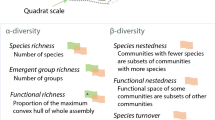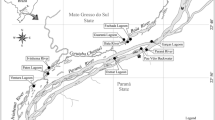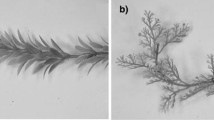Abstract
An ichnofabric includes all structure and textural changes of the sediment resulting from bioturbation (and bioerosion) at all scales. Abundance and distribution of burrows reflects the non-linear sorting effects of physical and biological parameters, resulting in a disturbance regime which generates patchiness. To analyze the patch dynamics of trace fossils as a result of environmental disturbance, this study quantifies bioturbation rates and spatial and temporal variation based on fractal geometry. Multifractal spectrum is used as a measure of spatial ichnofabric heterogeneities. The magnitude of the Daedalus ichnofabric fluctuations for the two stratigraphic sequences sampled shows that sandflat substrate colonization by the Daedalus halli worm producer after each storm event was opportunistic, mostly multigenerational, with an exclusive and significant occupation of emptied ecospace, for the purpose of meiofauna harvesting in clean sands.
Access this chapter
Tax calculation will be finalised at checkout
Purchases are for personal use only
Similar content being viewed by others
References
Pemberton, S. G., Frey, R. W., Saunders, T. D. A. (1990). Trace fossils. In D. E. G. Briggs, & P. R. Crowther (Eds.), Palaeobiology: a synthesis (pp. 355–361). Oxford : Blackwell Science.
Ekdale, A. A., & Bromley, R. G. (1983). Trace fossils and ichnofabrics in the Kjolby Gaard Marl, uppermost Cretaceous, Denmark. Bulletin of the Geological Society of Denmark, 31, 107–119.
Taylor, A., Goldring, R., & Gowland, S. (2003). Analysis and application of ichnofabrics. Earth-Science Reviews, 60, 227–259.
Reineck, H.-E. (1963). Sedimentgefuege im Bereich der suedlichen Nordsee. Abhandl. der Senckenb. Naturforsch. Gesellsh., 505, 1–138.
Droser, M. L., & Bottjer, D. J. (1986). A semiquantitative field classification of ichnofabric. Journal of Sedimentary Petrology, 56, 558–559.
Miller, M. F., & Smail, S. E. (1997). Multifractal characterization of microbially induced magnesian calcite formation in Recent tidal flat sediments. Palaios, 12, 391–396.
Sá, A. A., Meireles, C., & Coke, C. (2002). Concentração maciça de Daedalus labechei (Rouault) (Icnofóssil Ordovícico) no Alto do Martim Preto (Guadramil-Bragança): Património paleontológico a preservar e divulgar. In J. Civis , & J. A. González Delgado (Eds.), XVIII Jornadas de la Sociedad Española de Paleontología/II Congreso Ibérico de Paleontología (pp. 138–139). Salamanca: Libro de Resúmenes.
Durand, J. (1985). Le Grés Armoricain. Sédimentologie, Traces Fossiles, Milieux de dépôt. Mem. et Doc. du Centr. Armor. d’Etude Struct. des Socles 3, pp. 1–119.
Seilacher, A. (2000). Ordovician and Silurian arthrophycid ichnostratigraphy. In: M. A. Sola, & D. Worsley (Eds.), Geological exploration in Murzuq Basin (pp. 237–258). Amsterdam: Elseiver.
Gibert, J. M., Jeong, K., & Martinell, J. (1999). Ethologic and ontogenetic significance of the Pliocene trace fossil Sinusichnus sinuosus from the northwestern Mediterranean. Lethaia, 32, 31–40.
Neto de Carvalho, C. (2006). Roller coaster behaviour in the Cruziana rugosa group from Penha Garcia (Portugal): implications for the feeding program of Trilobites. Ichnos, 13(4), 255–265.
Baucon, A. (2010). Da Vinci’s Paleodictyon: the fractal beauty of traces. Acta Geologica Polonica, 60(1), 3–17.
Kropp, J., Block, A., Bloh, W., Klenke, T., & Schellnhuber, H. J. (1997). Multifractal characterization of microbially induced magnesian calcite formation in Recent tidal flat sediments. Sedimentary Geology, 109, 37–51.
Hentschel, H. G. E., & Procaccia, I. (1983). The infinite number of generalized dimensions of fractals and strange atractors. Physica D, 8, 4435–4444.
Author information
Authors and Affiliations
Corresponding author
Editor information
Editors and Affiliations
Rights and permissions
Copyright information
© 2014 Springer-Verlag Berlin Heidelberg
About this paper
Cite this paper
Neto de Carvalho, C., Baucon, A. (2014). Multifractals and Capacity Dimension as Measures of Disturbance Patch Dynamics in Daedalus Ichnofabrics. In: Pardo-Igúzquiza, E., Guardiola-Albert, C., Heredia, J., Moreno-Merino, L., Durán, J., Vargas-Guzmán, J. (eds) Mathematics of Planet Earth. Lecture Notes in Earth System Sciences. Springer, Berlin, Heidelberg. https://doi.org/10.1007/978-3-642-32408-6_161
Download citation
DOI: https://doi.org/10.1007/978-3-642-32408-6_161
Published:
Publisher Name: Springer, Berlin, Heidelberg
Print ISBN: 978-3-642-32407-9
Online ISBN: 978-3-642-32408-6
eBook Packages: Earth and Environmental ScienceEarth and Environmental Science (R0)




